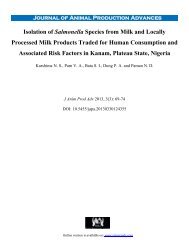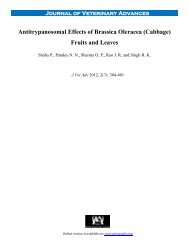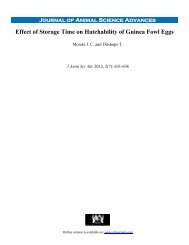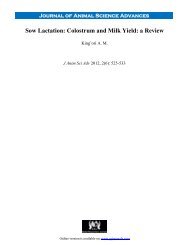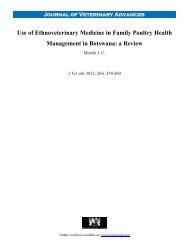Create successful ePaper yourself
Turn your PDF publications into a flip-book with our unique Google optimized e-Paper software.
EGG QUALITY DEFFECTS: TYPES, CAUSES AND OCCURRENCE …<br />
difficulty during hatching (Rogue et al, 1994) and<br />
deterioration on quality for table eggs.<br />
Viral infections (Infectious bronchitis (IB),<br />
Newcastle disease (ND) and Egg drop syndrome<br />
(EDS)) can lead to loss of shell colour, as well as<br />
egg deformities and a reduction in egg numbers<br />
(Thear, 2005). IB virus causes soft/rough shelled<br />
eggs, discolouration and wrinkling of the shell. Egg<br />
drop syndrome (EDS) is a viral infection that results<br />
in a reduced number of eggs, as well as an increased<br />
number of pale-shelled eggs. EDS virus affects only<br />
the shell gland but with ND or IB, every portion of<br />
the reproductive tract can be affected. The<br />
roughness of the egg shell increases with age and<br />
when serious may result in some downgrading.<br />
Molting corrects the problem to a degree, but when<br />
flocks are kept in lay beyond 30–40 weeks, many<br />
eggs become very rough and consumers may find<br />
this displeasing. The hen loses her ability to<br />
mobilize calcium from the bone, and is less able to<br />
produce the needed calcium carbonate. The<br />
absorption and mobilization of calcium decreases to<br />
less than 50% of normal after 40 weeks of age. The<br />
practice of "forced" or "induced" moulting has been<br />
shown to improve shell quality in all ageing flock.<br />
Following the moult, egg specific gravity, shell<br />
weight, shell thickness and percentage shell are<br />
either the same as they were prior to the moult, or<br />
had improved, for all strains. Induced moulting<br />
improves egg shell breaking strength in all strains.<br />
Use of certain chemotherapeutic agents can affect<br />
the intensity of pigmentation. Sulfa drugs affect the<br />
eggshell quality. The presence of the coccidiostat<br />
Nicarbazin in the feed can produce paler shells<br />
(Thear, 2005).<br />
Poor housing, high ambient temperature, rough<br />
handling of the eggs will affect the eggshell quality.<br />
Since large eggs are more prone to cracks, the egg<br />
size must be managed through proper nutritional<br />
and lighting management. Eggs from hens in the<br />
3L: 1D (3 days light: 1 day dark) regimen had a<br />
significantly greater shell breaking strength than<br />
eggs from hens in the 16L: 8D (16 hours light: 8<br />
hours dark) regimen. The hens on the 3L: 1D<br />
regimen have longer dark hours when calcium<br />
absorption is highest (Neospark, 2012). Eggshell<br />
quality is somewhat compromised during summer<br />
months. One of the factors contributing to poorer<br />
eggshell quality in hot weather is inadequate feed<br />
intake. Temporary thinning of the egg shell may<br />
occur during periods of high ambient temperature<br />
(above 25ºC) since feed intake is reduced. The<br />
shells quickly regain normal thickness when<br />
temperatures are reduced and feed intake increases.<br />
During heat stress calcium intake is reduced as a<br />
direct consequence of reduced feed intake and this<br />
stimulate bone resorption resulting in<br />
hyperphosphatemia. This inhibits the formation of<br />
calcium carbonate in the shell gland. Also heat<br />
stress reduces carbonic anhydrase (Zinc dependent<br />
enzyme) activity in the uterus. Under heat stress<br />
more blood is shunted to the peripheral tissues with<br />
concomitant reduction in flow of blood to the<br />
oviduct resulting in poor shell quality. The ability of<br />
layers to convert vitamin D3 to its active form is<br />
reduced during heat stress.<br />
During exposure to warm environmental<br />
temperature, the hen reacts by increasing its rate of<br />
breathing (panting) in order to cool itself. This<br />
causes the lowering of carbon dioxide in the blood<br />
and produces a condition termed "respiratory<br />
alkalosis". The pH of the blood becomes alkaline<br />
and the availability of calcium for the eggshell is<br />
reduced. This disturbance in acid-base balance<br />
causes an increase in soft-shelled eggs during<br />
summer. Respiratory alkalosis also causes increased<br />
carbonate loss through the kidney resulting in<br />
competition between kidney and uterus for<br />
carbonate ion, consequently resulting in poor<br />
eggshell thickness.<br />
The shell is formed by the activity of cells<br />
lining the oviduct and uterus. Under stress the<br />
secretions of these cells become acidic and the cells<br />
can be damaged or destroyed. In extreme cases,<br />
stress induced effects can result in eggshells that<br />
have excess deposits of calcium - a sort of powdery<br />
"bloom" on the surface and result in misshapen<br />
eggs. The presence of parasitic red mites that<br />
emerge at night to feed on the perching hens can<br />
have a debilitating effect on the birds, leading to<br />
anaemia, poor shell thickness and loss of egg<br />
colour. The presence of parasitic worms can also<br />
debilitate the hens to the extent that their nutritional<br />
intake is affected that leads to the production of<br />
eggs with deffects. A sudden disturbance to the<br />
normal routine may result in a hen retaining the egg<br />
353 J. Anim. Prod. Adv., 2012, 2(8):350-357




